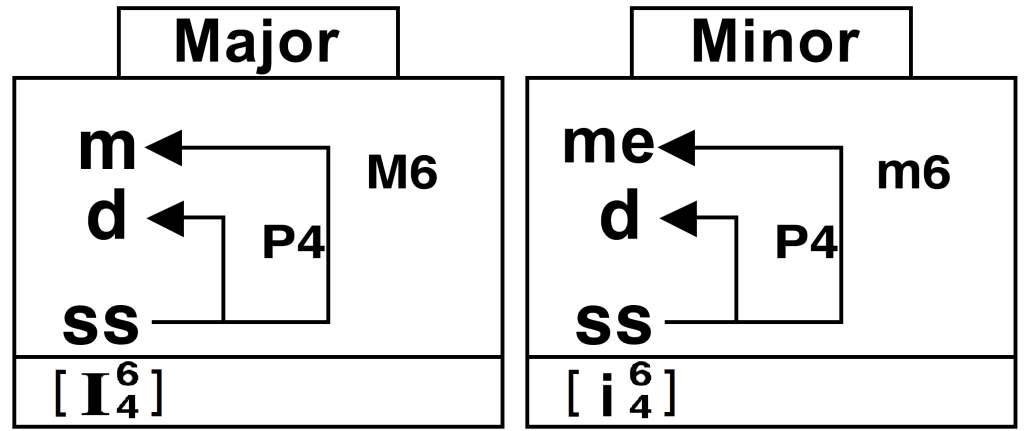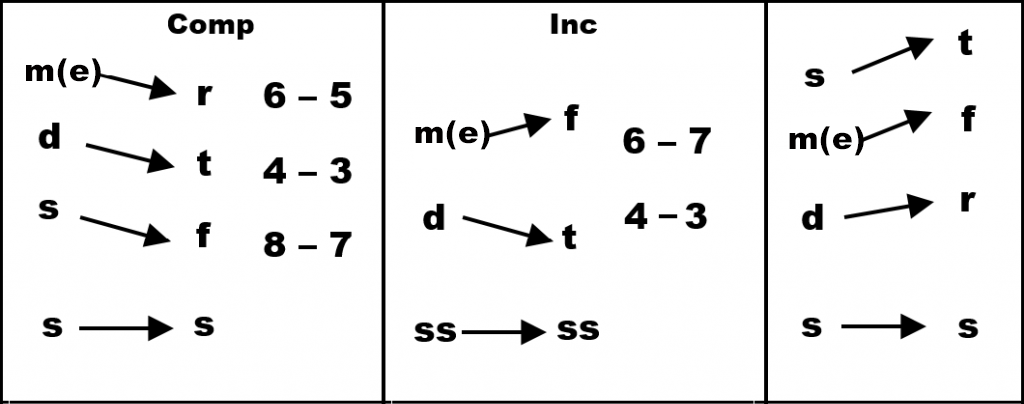5 Cadential Six-Four Chord
The cadential [I ![]() ] chord has the intervals of a 6th and 4th over the bass. The bass is the fifth of the chord and is always doubled.
] chord has the intervals of a 6th and 4th over the bass. The bass is the fifth of the chord and is always doubled.
For a review of chord inversions, see Review: Chord Inversions and Figured Bass.

In the Roman numeral analysis, the chord is written in brackets to indicate that it is functioning in a linear manner as an introduction to V or V7.

Voice Leading
All examples also work in harmonic minor by adding me, and in open spacing by lowering the alto by an octave.
1. [ I ![]() ] – V
] – V

1a – 1c. The 6th and the 4th above the bass move down by step. The octave above the bass remains stationary. The bass remains stationary or drops an octave to the root of the V chord.
1d. The so – ti soprano is harmonized by moving the upper three voices of the cadential [ I ![]() ] chord upwards in a non-common tone connection to V.
] chord upwards in a non-common tone connection to V.
2. [ I ![]() ] – V7
] – V7

2a. To create a complete V7, the upper three voices move down (8-7, 6-5, 4-3).
2b. m(e) can move up to fa to create an incomplete V7.
2c. The so – ti soprano can be harmonized by moving the upper three voices of the cadential [ I ![]() ] chord upwards in a non-common tone connection to V7.
] chord upwards in a non-common tone connection to V7.
The bass remains stationary or drops an octave.
Placement of the cadential [ I  ] chord
] chord
The cadential [ I ![]() ] chord always appears in a metrically stronger position than the following V or V7 chord.
] chord always appears in a metrically stronger position than the following V or V7 chord.
3a. The [ I ![]() ] chord is on beat 3, which in quadruple meter is metrically stronger than V7 on beat 4.
] chord is on beat 3, which in quadruple meter is metrically stronger than V7 on beat 4.
3b. The [ I ![]() ] chord is on beat 2, which in triple meter is metrically stronger than V on beat 3.
] chord is on beat 2, which in triple meter is metrically stronger than V on beat 3.
3c. The [ I ![]() ] chord is on a downbeat, which means the resolution can be on any part of the measure or on the downbeat of the next measure.
] chord is on a downbeat, which means the resolution can be on any part of the measure or on the downbeat of the next measure.
3d. Avoid [ I ![]() ] on a weak beat moving to V(7) on a strong beat.
] on a weak beat moving to V(7) on a strong beat.
Practice